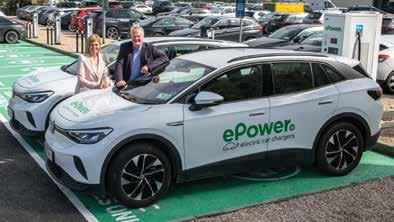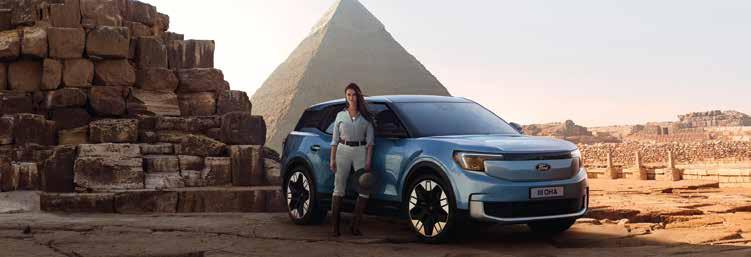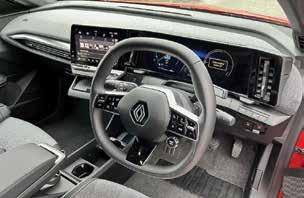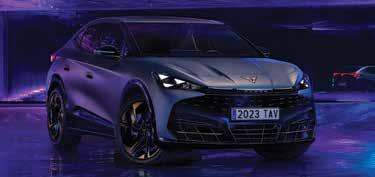Edited by Cathal Doyle - cathal@fleet.ie
EGM to close ALD acquisition of LeasePlan postponed to May
A scheduled Extraordinary General Meeting (EGM) of ALD to close its acquisition of LeasePlan has been postponed from 28 April to 22 May 2023. The deferment is because the company is awaiting final agreement from the European Commission for the sale of subsidiaries in six markets including Ireland.
French company ALD agreed to buy LeasePlan for €4.9 billion in January 2022, with the new leasing company to be known as NewALD. In November, EU

antitrust regulators cleared ALD’s bid for LeasePlan subject to the new entity agreeing to divest some businesses across Europe to address competition concerns.
ALD’s subsidiaries in Ireland, Portugal and Norway, and LeasePlan’s subsidiaries in Luxembourg, Finland and the Czech Republic are to be sold to Credit Agricole Consumer Finance and automotive manufacturer, the Stellantis Group. The combined fleet of these six entities represented approximately 100,000 vehicles or 3% of the total combined fleet of ALD and LeasePlan as at 31

December 2022.
ALD Automotive is the fleet management arm of French Bank Société Générale. It purchased what was Merrion Fleet Management in 2017, at the time the second largest leasing and fleet management company in Ireland. It currently has 9,000 vehicles under management. LeasePlan manages in excess of 21,500 vehicles in Ireland.


EV Charge Points installed at 13 hotel locations by ePower

Plaza Hotel Tallaght, Tallaght Cross Hotel, Mount Wolseley Hotel, Park
90 new electric vehicle charge points are being installed at 13 hotel locations throughout Ireland by hotel operators, Windward Management. The charging infrastructure was installed by ePower who supply, install, support and manage electric vehicle chargers throughout Ireland.
EV charging stations are now available at the following 11 hotels:
Connemara Coast Hotel, McWilliam Park Hotel, The Radisson Blu Dublin Airport,
Inn Shannon Airport, Aghadoe Heights, Cavan Crystal Hotel, Farnham Estate, and Harvey’s Point. Facilities at two additional hotels, The Fitzwilton Hotel and The Anner Hotel, are due to go live shortly.
The 22kW AC electric vehicle charge points are visible on several EV charging apps such as Plugsurfing, the ePower app and on the internationally used app, PlugShare.
Group General Manager at Windward Management Charlie Sheil believes
it’s a good investment for the future: “We are delighted to offer ePower Car Charging Facilities across our portfolio of hotels, feedback from customers has been fantastic so far and we are looking forward to expanding the facilities in line with our sustainability initiatives”.
Executive Director of ePower Hugh Hall says he’s delighted to be partnering with Windward: “The ePower team was pleased to install EV chargers for the Windward Managed hotels as they work to improve their approach to sustainability. As well as installing the equipment, we’re looking forward to growing our partnership as we manage and maintain the chargers at these Windward properties in the future”.
www.fleet.ie Volume 21 No. 3 May 2023 www.fleetcar.ie IRELAND’S FOREMOST FLEET & CORPORATE SECTOR GUIDE
Over one hundred years ago, Aloha Wanderwell became the first woman to drive around the world on an epic journey that took her through 43 countries. Partially sponsored by Ford Motor Company, she set the record in a Ford Model T between 1922 and 1927. Now, as Ford accelerates in its mission to lead the electric vehicle revolution, the company has joined forces with travel adventure influencer Lexie Alford – known to millions online as Lexie Limitless – to continue Wanderwell’s legacy of redefining exploration with an ambitious roundthe-world journey in the new all-electric Ford Explorer.
Beginning later this year, Lexie will lead an expedition around the globe, overcoming challenges, meeting people from many cultures, and visiting places of outstanding beauty, all supported by the zero-tailpipe emission Ford Explorer.

“We’re excited to see what our new all-electric Explorer and Lexie Alford can do together on this expedition – inspired by Aloha Wanderwell’s ground-breaking trip,” said Martin Sander, General Manager, Ford Model e, Europe at the launch event in London. “We were a part of Aloha’s journey all those years ago
Renault hits the mark with all-electric Megane E-Tech
This is quite a brave step by Renault. As quickly as we’re moving to a world of electric motoring, most manufacturers are continuing to hedge their bets by either offering petrol and/or diesel versions of their mainstream models alongside electric versions of the same car, or introducing separate electric models while continuing to offer equivalent ICE engined products.
Renault, though, has bitten the bullet with the latest generation Megane, dropping all ICE engined versions and instead putting all its eggs into the basket that is the all-electric Megane E-Tech. Whether that’s a step too far too soon will probably only be known once current supply chain issues are a thing of the past, though Renault will point to other models in its line-up such as the Arkana for those erstwhile Megane customers unwilling for now to go full-electric.
Styl ING
Now in its fifth generation, there have been previous iterations of Renault’s mid-sized family car that have had distinctive appearances, notably the Megane II of 2002 with its vertical rear window. This new model though certainly scores well in the style stakes, with a hint of SUV robustness about it, but lower and sleeker. Features like the flush door handles and strong LED light signatures give it a distinctive visual identity.
I N t E r IO r
Renault interiors would rarely be reviewed using the word ‘plush’ but the new Megane’s cabin is a definite step up from recent efforts from the brand, using a mixture of cloth like materials and good quality plastics. The view in front is dominated by two big screens that meld into one. The smaller one controls the multimedia functions while the main screen in front of the driver has clearly laid out information. A Multi-Sense
button on the steering wheel allows you to easily switch between driving modes.

Legroom in the back is adequate rather than palatial, but headroom is more generous than you might expect. There are lots of handy storage areas including an easily accessed wireless charging dock for your phone. The boot has quite a large lip to surmount but is deep with plenty of storage space.
Batt E ry, r a NGE a N d C H ar GING
The Megane E-Tech is offered in Ireland with two battery options - a 40kWh version (EV40) and the EV60 model tested here featuring a 60kWh battery. It comes with a 220 hp motor and 300Nm of torque (the smaller battery model is matched to a 130hp / 250Nm motor).

Stated range figures based on the WLTP cycle are 300km and 450km respectively, though in practice we didn’t see a range capability beyond 300km during a week with the EV60. In mitigation the weather was cold so a better figure is likely in more clement conditions.
Where the Megane E-Tech scores over many rivals is in its charging capabilities. While it can accept DC charging at speeds of up to 130kW, it can also charge at AC speeds of up to 22kW. Most rivals only offer up to 11kW AC charging as standard. With the relative proliferation of 22kW AC public charging stations compared to DC units, this gives the Renault much more flexibility when having to charge away from home.
A week driving the Megane E-Tech returned an average consumption figure of 19.5 kWh/100km over a mix of urban, rural and motorway driving. Low 18s were recorded on some journeys, making this one of the most efficient EVs we have tested to date.
rI d E a N d Ha N dl ING
With 220hp on tap, there’s no problem making rapid progress in the Megane E-Tech, though happily power is delivered in a linear manner unlike some EVs which can catch drivers unaware with their acceleration at low speeds. While there’s a little rigidity in the chassis on bumpy surface courtesy of the floor mounted batteries, it’s not a signifiant issue. Equally the Megane, which comes with multi-link suspension, handles and grips very nicely with more driver feedback than found in many crossover SUVs. A car you might actually enjoy driving!
Pr ICES
Pricing starts at €37,495 for EV40 versions featuring a 40kWh battery, and at €41,995 for EV60 versions featuring a 60kWh battery.
V E rd IC t:
Renault should have a winner with the new Megane E-Tech. Reasonably priced (for an EV) with respectable range and flexible charging solutions, it’s good to drive and stylish to boot. What’s not to like!
FLEETCAR | MAY 23 | NEWS 1
Text: Cathal Doyle, Photos: Jarlath Sweeney
78 | TEST I SPEC CHECK - rEN ault M EG a NE E-tech EV60 Price as tested €46,345 (inc govt grants) Drivetrain Front wheel drive, 1 speed automatic Electric Motor Output 220 bhp Torque 300 Nm Battery Useable capacity 60 kWh Charging speed capabilities Up to 130kW DC, 22kW AC Maximum quoted range (WLTP) 450 km Quoted energy consumption 16.1 kWh/100km Towing capacity 900 kg braked
Nissan X-Trail E-Power - a hybrid with a difference!

A new fourth generation of Nissan’s large family sized SUV has gone on sale. It boasts one significant difference to its predecessors….diesel versions have been dropped, while the X-Trail now comes with hybrid power.
Unlike the outgoing model which looked like a slightly larger Qashqai, the new X-Trail has a much strong visual identity. Wider and taller than before, it boasts stronger lines and strong shoulders giving it an assertive and distinctive identity. It’s one of the better looking SUVs on sale at present.

Nissan’s hybrid power is different to the normal technology seen in these kind of vehicles. Whereas normally an electric motor provides assistance to the internal combustion engine to power the wheels, Nissan’s system, which it calls ePower, uses the petrol engine - in this case a turbocharged 1.5-litre petrol unit - to provide charge to the electric motor (or motors depending on whether it is a two or four wheel drive model). Crucially though, it’s the electric motor that provides power to the wheels at all times, even when the petrol engine is running.
The main benefit of this system is that it brings the refined driving characteristics associated with pure electric vehicles such as a seamless gearshift via a 1-speed reduction gear, and the option of using E-Pedal - Nissan’s regenerative braking system that allows you to largely control the vehicle without recourse to the brake pedal.
The downside is that while it may drive like an EV, it won’t be a stranger to the petrol forecourts. On the fuel consumption front we averaged 7.0 l/100km (40.3mpg) after a week of largely gentle driving. That’s by no means disastrous but is arguably worse than you would expect from a conventional hybrid system. Official emissions are 148
g/km putting it into tax band 10 at €270 per annum (Band 9 for the front wheel drive only model).
Don’t expect either to spend too much time driving on electric power as we found the petrol engine is active most of the time. It’s pretty unobtrusive though, and because it is there as a generator, you only will really notice it if you are pressing on and the engine needs to work harder to generate sufficient energy.
The X-Trail rides bumpy surfaces well and performance is more than adequate with a 0-100km/h time of 7.2 seconds. It’s not necessarily a car you will want to push on in too much, but having that power available just in case is reassuring. Driving modes of Sport, Eco, Standard, Snow and Off-Road give extra options to meet specific driving demands.
Powertrain aside, there’s quite a lot to like about the new X-Trail, not least its upmarket feel, at least in the range-topping 7-seater model in SVE trim tested here. In this specification the X-Trail can stand shoulder to shoulder with rivals from more prestigious brands. Soft touch materials and an ergonomic layout give the cabin a premium ambiance and make the cabin a pleasant place in which to spend time. We found the seats
comfortable as well on longer journeys. The rear seats slide forward and back by generous amounts giving extra flexibility depending on whether you need extra space in the back for luggage, or to accommodate passengers in the third row of seats. On that point, Nissan is presently offering the X-Trail ePower in either front wheel drive with five seats, or as a 4WD seven seater. However there is a significant jump in price of circa €10k if you need those extra two seats, while it should be noted that, like many SUV seven seaters of this type, those third row seats are really only suitable for smaller children.
V E rd IC t:
This latest X-Trail brings fresh life to Nissan’s large family SUV, with a style and finish that compares favourably to premium level rivals. Kudos too to Nissan for coming up with a different approach to hybrid technology, one that offers EV-like driving refinement with instant linear acceleration, though fuel economy is a little on the disappointing side. While the option of seven seats is useful, it does add significantly to the price, so for most buyers we feel the front wheel drive five seater will make most sense.
Text & Photos: Cathal Doyle - cathal@fleet.ie
www.fleet.ie TEST II | 79
S PEC C HECK - N ISS a N X- t ra I l E P OWE r SVE 7 S E at E r 4W d Price as tested €66,245 Price range for X-Trail €49,495 - €66,245 Drivetrain Four wheel drive, 1 speed automatic. Dual electric motors - one on each axle Petrol motor generator 1.5-litre 3-cylinder turbo with a variable compression ratio Electric motors power output 210 bhp 0-100km/h 7.2 seconds Stated fuel economy (WLTP) 6.6 l/100km (42.8 mpg) CO2 Emissions 148g/km
Now under Stellantis Group ownership, as well as part of the burgeoning Gowan Group distributors in Ireland, there are genuine reasons to hope for a revival in the fortunes of the Alfa Romeo brand. Ultimately that will come down to the quality of product and the strength of the dealer network, Currently Alfa operates three
Alfa Romeo makes a fresh start with new Tonale
dealerships in Dublin, Cork and Waterford, but has plans to significantly expand that in the next couple of years.
Available in mild hybrid and plug-in hybrid variants, the mid-sized crossover Tonale is the first Alfa to come with electrification, but it won’t be the last - by 2027 the company plans to be an electric-only brand. The 48 Volt mild hybrid MHEV uses a 1.5 petrol with variable geometry turbo that develops 160hp and has 115 g/km of CO2 emissions. Opt for

BYD enters Irish market with ATTO 3 SUV
Best known for its electric buses which are in operation in numerous cities around Europe, Chinese corporation BYD (Build Your Dreams), a leading leading manufacturer of new energy vehicles and power batteries has now launched in Irish market with the arrival of the all-new, all-electric BYD ATTO 3 C-segment SUV.
Created by former Audi Group head designer, Wolfgang Egger, this new BYD ATTO 3 is styled with European customers in mind and comes equipped with exceptionally high levels of standard equipment, including a Panoramic Sunroof, BYD’s attention to detail can be seen throughout, extending to its unique interior to give the ATTO 3 an added dimension of youthful flair and
personality.
The ATTO 3 range consists of ‘Comfort’ and ‘Design’ trim levels to be followed by an ‘Active’ model variant – all part of the Phase One scheduling of BYD’s launch into the Irish market. Taking account of its high level of standard specification, its many innovative features, and its extensive range of high-tech elements, the ATTO 3 is introduced at what its distributor says is ‘an appealingly-competitive price level’ beginning from €37,128. GPS Navigation features as standard. A focal feature is its unique 12.8 inch rotatable touchscreen (15.6 inch on Design versions) with voice recognition delivering an abundance of connected experiences and integrated
the plug-in hybrid (PHEV Q4) and you get all wheel drive, a total power output of 280hp from a 1.3 Multijet petrol engine and 90kW electric motor, and a promised range of up to 60km on electric only power. Official emissions are 29 g/km. There are two standard trims - TI and Veloce, as well as an exclusive Edizione Speciale spec available with the PHEV only. Prices for the MHEV start from €49,995, while those for the PHEV are from €53,495.

Volkswagen has unveiled the latest model in its all-electric family - the ID.7. Set to arrive in Ireland by the end of the year in time for the 241 registration plate, it’s a traditional styled saloon unlike the more upright SUV styled ID 3,4 & 5 models.

That lower styling gives the ID.7 an impressively low Cd rating of just 0.23, which combined with Volkswagen’s
Apps.
BYD ATTO 3 promises a (WLTP combined) electric range of 420km, with energy consumption as low as 16.3kWh/100km or less. It will initially be available through dealerships in Dublin and Cork – BYD North Dublin, Navan Road; BYD South Dublin, Deansgrange and BYD Cork Eastgate Business Park, Little Island. Additional sales dealerships to be announced shortly.
Jarlath Sweeney
Volkswagen expands electric product offerings with ID.7
biggest battery to date - an 86kWh unit that combined with the slippery shape of the low slung car, promises a range of up to 700km. That battery can also accept fast charging at speeds of up to 200kW and comes with a new electric motor developing 286hp that powers the rear wheels. The familiar 77kWh battery seen in current ID models will also be available, with Volkswagen saying it will deliver a range of up to 613km.
The ID.7 features a new operating
and display system that includes a 38-centimetre infotainment system screen with a now thankfully back-lit touch slider, and an augmented reality head-up display. There’s a more intuitive voice control system a new air conditioning operating system is integrated on the top level of the infotainment system with freely assignable favourites buttons. Other notable features include seat Climatronic with massage function and a panoramic sunroof with switchable smart glass.
Cathal Doyle
FLEETCAR | MAY 23 | NEWS 1
Cathal Doyle
80 | LAUNCH PAD
It may not be a new name in the car industry but Jeep has called its new compact electric SUV the Avenger. Bearing no relation at all to the Hillman Avenger from the ‘70s, the fully electric Jeep Avenger is designed and produced in Europe and has been designed to perfectly fit the needs of European customers.

New Jeep Avenger set for new Adventure!
Avenger offers a range of up to 400km WLTP, while its standard fast charging mode allows it to recharge 30km (average daily need) in 3 minutes, and to go from 20 to 80% in 24 minutes. Its energy consumption is estimated at 15.4 kWh per 100 km in the WLTP cycle. This new adventurer features a 10.25” infotainment display offering ‘i-Phone-like’ experience. It comes with ‘Selec-Terrain’ driving modes and Hill
New E-Class breaks cover
Mercedes-Benz has taken the wraps off the next generation E-Class. The W214 model is expected to go on sale this autumn. It will sell alongside the all-electric EQE and will include a number of hybrid options in its line-up as well as petrol or diesel options.

The new E-Class retains the classic saloon styling of its predecessors with styling cues from the flagship S-Class. Inside there’s the latest version of Mercedes-Benz’s MBUX infotainment operating system, with the central screen integrated into the dashboard. There’s an optional extra screen available in front of the passenger which integrates with the central display.
Six engines will be available at launch
(though not all may be on sale in Ireland). Of those, three are plug-in hybrids, with volume sales to be expected from the E 300 e model which combines a plug-in hybrid electric motor developing 95kW with a 204hp 2.0 petrol, giving a total power output of 312hp. Available in rear wheel or 4Matic 4WD, Mercedes says the E 300 e can travel on electric power for up to 115km (109km for the 4Matic version).
Among the features offered on the new C-Class is an artificial intelligence system which can pre-set the cabin to
Descent Control for all-road, all-weather driving, which is a ‘given’ on a Jeep.
At the launch Eric Laforge, newly appointed Head of Jeep Brand in Europe, said: “Avenger is the right choice for those looking for a compact, robust, and “cool” car which offers state-ofthe-art technology, space and comfort while delivering lots of fun. Ideal for commuting as well as for going on vacation, for shopping, for trailing, for clubbing and for sharing. With Avenger you can do anything and go anywhere.”
Jarlath Sweeney
Designed and developed in Barcelona, the CUPRA Tavascan, is derived directly from the Tavascan concept from 2019, and continues the Spanish brand’s electrification journey.
CUPRA Tavascan was created to perfectly match electrification and performance; the most powerful version delivers 250kW, with dual-motor all-wheel drive system. There is also a
your preferred settings as you approach the car. You can also lock and start the car using an iPhone or Apple Watch. Entertainment wise, third party apps such as TikTok, Angry Birds and Zoom can be installed on the infotainment system, while for those who prefer to focus on driving enhancements, Airmatic air suspension and rear-axle steering are options.
Cathal Doyle
CUPRA Tavascan: From dream to reality
rear-wheel drive variant delivering 210kW (286PS) with an electric motor placed on the rear axle. All the vehicles’ performance is matched by the battery technology, with enough energy storage to travel around 550km on a single charge.
“The brand’s journey towards electrification is its unstoppable impulse – it’s at the heart of everything we do. CUPRA is transforming itself towards a fully electrified brand by 2030. There are so
many purely rational electric cars coming to the market. That’s not what CUPRA is about” said Wayne Griffiths, CUPRA CEO at the reveal. “In 2019, we had a vision to reinvent electrification: we wanted to show with Tavascan that it’s not a vehicle responding to change, but a car that creates it. Back then maybe it was only a dream. Now with the CUPRA Tavascan, our dream comes true.”
The Tavascan will be produced at the Volkswagen Group’s Anhui factory in China, and will be launched in 2024, with a yearly sales target of more than 50,000 units.
 Jarlath Sweeney
Jarlath Sweeney
www.fleet.ie L AUNCH PAD | 81
The Government’s confused thinking on company car policy has been highlighted by its decision to change benefit-in-kind (BIK) tax bands with effect from the start of the year.

The official line is that the move to incorporate CO2 emissions into the BIK calculations (along with the car’s original market value (OMV) and annual mileage covered) will encourage business employees into electric cars and less polluting and greener vehicles.
However, leasing market experts are adamant that the move will have the opposite effect, and that the overall less favourable BIK rates across the board will force more people to walk away from their company car altogether, and instead opt for an older and more polluting privately owned vehicle.
The fact that the threshold below which 0% BIK is applied on electric vehicles is being lowered - from the previous €50,000 to €35,000 this year, and down to €20,000 in 2024 and €10,000 in 2025 - further undermines the Government’s assertion of wanting to encourage company car drivers to make the switch to EVs.
While the subsequent announcement in March of a temporary (until the end of the year) reduction in OMV for BIK calculation by €10,000 on all but the most polluting cars will be welcomed, anecdotal evidence seems to back up the fear that employees will increasingly choose to walk away from their company cars. In the past month I have spoke to

















 Jarlath Sweeney
Jarlath Sweeney







